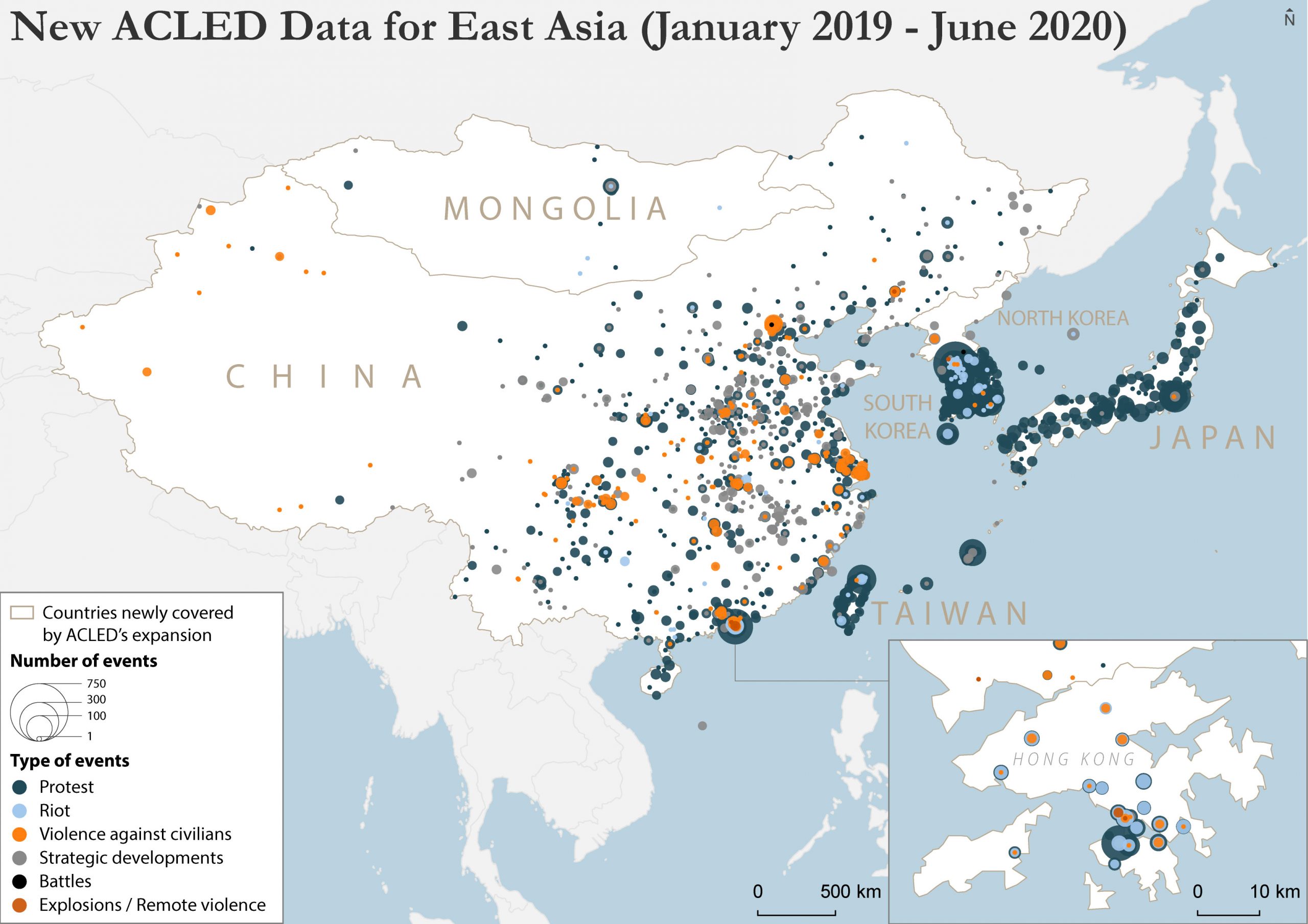30 June 2020: The Armed Conflict Location & Event Data Project (ACLED) has now expanded real-time coverage to East Asia. The new data span six countries — China, Taiwan,1 For more information on ACLED’s decision to code Taiwan as distinct from China, see this methodology brief. Japan, Mongolia, South Korea, and North Korea2Because of the difficulty in accessing reliable information from within North Korea, and given the nature of the conflict between North and South Korea, the vast majority of events in the North Korean dataset are coded as “Strategic developments.” For more information on the unique data collection challenges presented by North Korea, see this methodology brief. — and add over 12,870 political violence, demonstration, and strategic development3The “Strategic development” event type captures contextually important information regarding the activities of violent groups that is not itself recorded as political violence or a demonstration, yet may trigger future events or contribute to political dynamics within and across states. For more information on the scope and useability of these types of events, see the ACLED Codebook and this methodology primer. events to the ACLED dataset from the beginning of 2019 to the present.
For more information, check out the launch report and our interactive East Asia dashboard.
Political Violence, Demonstrations, and Strategic Developments in East Asia
- From 1 January 2019 to 27 June 2020, ACLED records more than 12,870 political violence, demonstration, and strategic development events across the region
- Over 11,630 are demonstration events
- The vast majority of these events are peaceful protests
- The highest number of demonstration events are reported in South Korea
- Over 560 are political violence events
- Violence against civilians accounts for 89% of all violent events in the region
- Approximately 57% of all political violence events are abductions/forced disappearances of civilians in China, which is home to the vast majority — 94% — of political violence reported in East Asia
- State forces are the primary perpetrators of violence against civilians in China, accounting for 78% of all violence against civilians in the country
- Over 11,630 are demonstration events
- Demonstration events have decreased across the region amid the COVID-19 pandemic, while political violence has largely held steady (see In Focus section on the impact of COVID-19 below)
In Focus: Protest Movements
Demonstrations are the most common event recorded by ACLED in East Asia, with more than 11,630 events reported throughout the region since the start of 2019. Demonstrators have taken to the streets over a range of issues, including: domestic political concerns in mainland China, Hong Kong, and South Korea; climate change in Taiwan; nuclear power in Japan; corruption in Mongolia; labor rights in South Korea; and international relations, with anti-Japan protests in South Korea and protests against the American military in Japan. In the wake of COVID-19, demonstrators have also rallied over government pandemic responses as well as the economic fallout of the crisis.
- Peaceful protests account for approximately 96% of all demonstration events in East Asia, with violent riots accounting for just 4%
- Over 3% of all peaceful demonstrations are met with intervention or excessive force
- These events are predominantly reported in China and Japan
One of the region’s most intense protest movements was sparked by proposed legislation in Hong Kong that would have allowed criminal suspects to be extradited to mainland China. At the height of the movement between July and December 2019, demonstration events in Hong Kong increased by 217% compared to the previous six months — from 262 events to 831 events. Just today, 30 June 2020, the Chinese government enacted a controversial new security law that expands its authority over Hong Kong, threatening to trigger renewed unrest.
- Approximately 49% of all demonstration events reported in Hong Kong between July and December 2019 were directly related to the anti-extradition bill movement, which kicked off in early June
- A significant percentage — approximately 39% — of the anti-extradition bill demonstration events during this period were violent, with some demonstrators throwing petrol bombs and destroying property
- The anti-extradition bill movement began to slow in January 2020 amid the COVID-19 pandemic, but demonstrations have started to pick back up since May with the easing of lockdown measures
In Focus: Impact of COVID-19
Since the start of the coronavirus outbreak, demonstration events have decreased overall across East Asia — even as the pandemic itself has generated unrest around the region, from car protests in South Korea to violent enforcement of COVID-19 restrictions in China.
- ACLED records a 26% decline in demonstration events over the first five months of 2020 compared to the last five months of 2019
- The largest decreases are reported in Taiwan, with a 56% decline, and China, with a 53% decline
- At the same time, ACLED records 550 political violence and demonstration events directly related to COVID-19 and state pandemic responses since the beginning of the crisis
- 89% of these events are protests, followed by violent riots at 4%
- South Korea has registered the highest number of coronavirus-related events, with more than 230 — 42% of the region-wide total

A US-based 501(c)(3) non-profit organization established in 2014, ACLED is the highest quality and most widely used real-time data and analysis source on political violence and protest around the world.
If you would like to use ACLED data and analysis, please review our Terms of Use and Attribution Policy. For more information about ACLED methodology and resources for analyzing the data, visit our General Guides and Methodology pages.
For interview requests and press inquiries, please contact: Sam Jones, Communications Manager
© 2020 Armed Conflict Location & Event Data Project (ACLED). All rights reserved.




